Healthcare Professionals and Substance Abuse: A Media Analysis Report
VerifiedAdded on 2023/06/10
|10
|2270
|234
Report
AI Summary
This media analysis report examines the issue of substance abuse among healthcare professionals, drawing on three different articles to explore the causes, consequences, and potential solutions. The report highlights the increased rates of substance misuse and addiction among healthcare workers, often attributed to job stress, demanding work environments, and easy access to drugs. The analysis discusses articles from CBC News, M Health Lab, and the Physician Health Program, each offering unique perspectives on the issue, including the role of compassion fatigue, opioid access, and the vulnerability of emergency department staff. The author provides an evaluation of the articles, discussing the importance of understanding addiction symptoms and the need for proper interventions, such as counselling and policy changes. The report concludes with the author's personal and professional values, emphasizing the importance of ethical conduct, patient care, and the rejection of substance abuse as a coping mechanism. The author's professional values align with the Canadian Nurses Association's Code of Ethics and personal values that strictly condemn the use of sedatives to deal with stress.
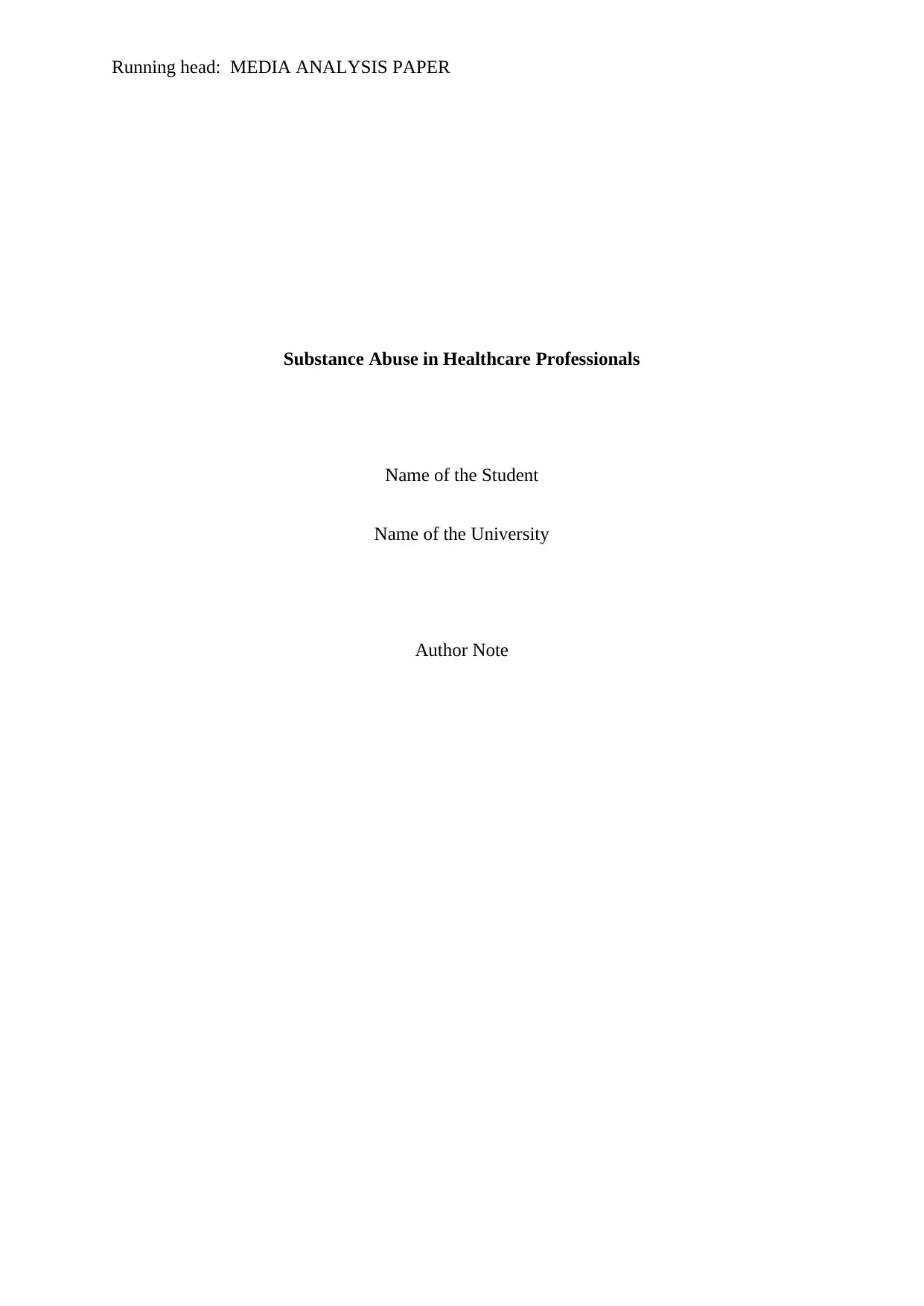
Running head: MEDIA ANALYSIS PAPER
Substance Abuse in Healthcare Professionals
Name of the Student
Name of the University
Author Note
Substance Abuse in Healthcare Professionals
Name of the Student
Name of the University
Author Note
Paraphrase This Document
Need a fresh take? Get an instant paraphrase of this document with our AI Paraphraser
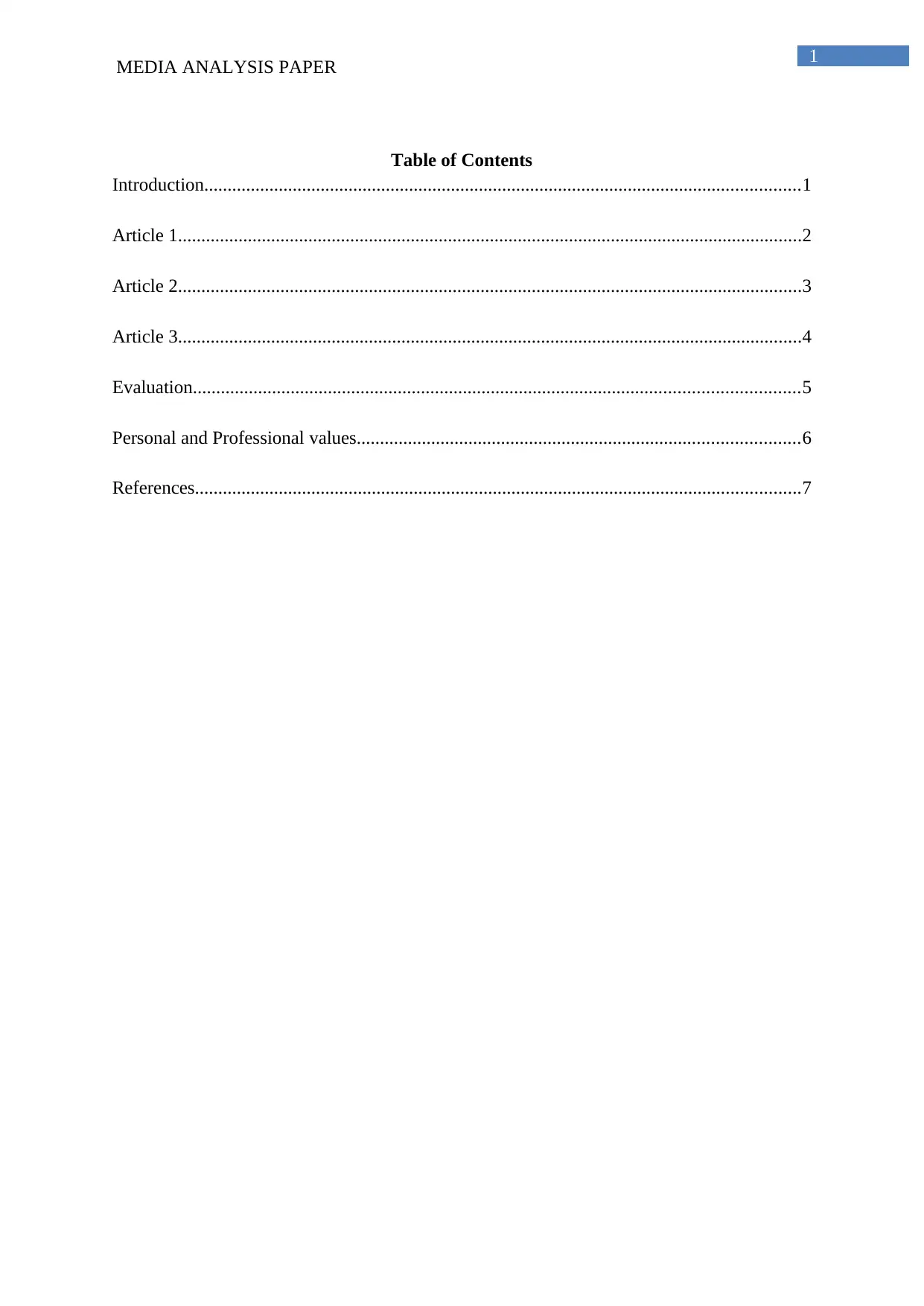
1
MEDIA ANALYSIS PAPER
Table of Contents
Introduction................................................................................................................................1
Article 1......................................................................................................................................2
Article 2......................................................................................................................................3
Article 3......................................................................................................................................4
Evaluation..................................................................................................................................5
Personal and Professional values...............................................................................................6
References..................................................................................................................................7
MEDIA ANALYSIS PAPER
Table of Contents
Introduction................................................................................................................................1
Article 1......................................................................................................................................2
Article 2......................................................................................................................................3
Article 3......................................................................................................................................4
Evaluation..................................................................................................................................5
Personal and Professional values...............................................................................................6
References..................................................................................................................................7
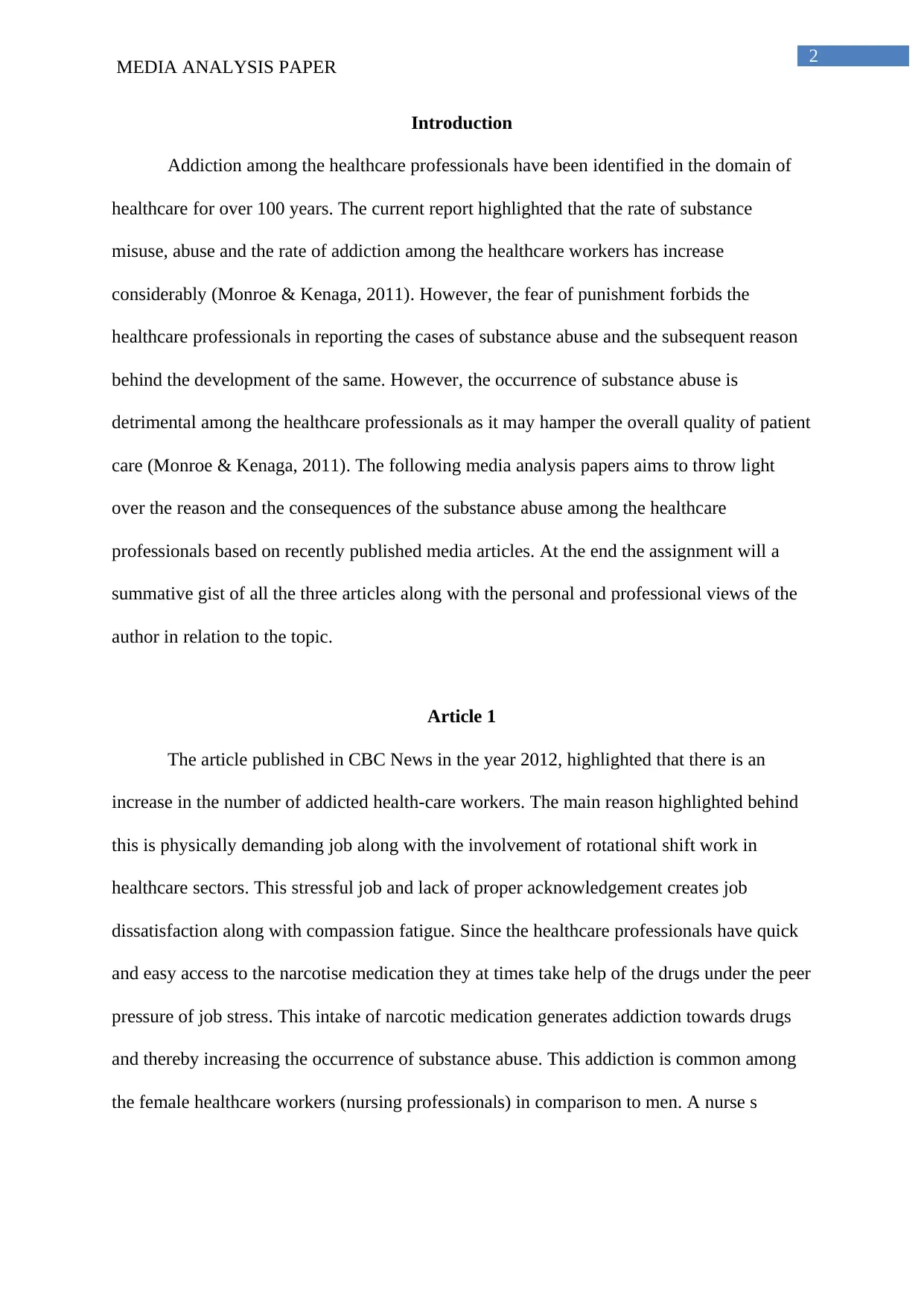
2
MEDIA ANALYSIS PAPER
Introduction
Addiction among the healthcare professionals have been identified in the domain of
healthcare for over 100 years. The current report highlighted that the rate of substance
misuse, abuse and the rate of addiction among the healthcare workers has increase
considerably (Monroe & Kenaga, 2011). However, the fear of punishment forbids the
healthcare professionals in reporting the cases of substance abuse and the subsequent reason
behind the development of the same. However, the occurrence of substance abuse is
detrimental among the healthcare professionals as it may hamper the overall quality of patient
care (Monroe & Kenaga, 2011). The following media analysis papers aims to throw light
over the reason and the consequences of the substance abuse among the healthcare
professionals based on recently published media articles. At the end the assignment will a
summative gist of all the three articles along with the personal and professional views of the
author in relation to the topic.
Article 1
The article published in CBC News in the year 2012, highlighted that there is an
increase in the number of addicted health-care workers. The main reason highlighted behind
this is physically demanding job along with the involvement of rotational shift work in
healthcare sectors. This stressful job and lack of proper acknowledgement creates job
dissatisfaction along with compassion fatigue. Since the healthcare professionals have quick
and easy access to the narcotise medication they at times take help of the drugs under the peer
pressure of job stress. This intake of narcotic medication generates addiction towards drugs
and thereby increasing the occurrence of substance abuse. This addiction is common among
the female healthcare workers (nursing professionals) in comparison to men. A nurse s
MEDIA ANALYSIS PAPER
Introduction
Addiction among the healthcare professionals have been identified in the domain of
healthcare for over 100 years. The current report highlighted that the rate of substance
misuse, abuse and the rate of addiction among the healthcare workers has increase
considerably (Monroe & Kenaga, 2011). However, the fear of punishment forbids the
healthcare professionals in reporting the cases of substance abuse and the subsequent reason
behind the development of the same. However, the occurrence of substance abuse is
detrimental among the healthcare professionals as it may hamper the overall quality of patient
care (Monroe & Kenaga, 2011). The following media analysis papers aims to throw light
over the reason and the consequences of the substance abuse among the healthcare
professionals based on recently published media articles. At the end the assignment will a
summative gist of all the three articles along with the personal and professional views of the
author in relation to the topic.
Article 1
The article published in CBC News in the year 2012, highlighted that there is an
increase in the number of addicted health-care workers. The main reason highlighted behind
this is physically demanding job along with the involvement of rotational shift work in
healthcare sectors. This stressful job and lack of proper acknowledgement creates job
dissatisfaction along with compassion fatigue. Since the healthcare professionals have quick
and easy access to the narcotise medication they at times take help of the drugs under the peer
pressure of job stress. This intake of narcotic medication generates addiction towards drugs
and thereby increasing the occurrence of substance abuse. This addiction is common among
the female healthcare workers (nursing professionals) in comparison to men. A nurse s
⊘ This is a preview!⊘
Do you want full access?
Subscribe today to unlock all pages.

Trusted by 1+ million students worldwide
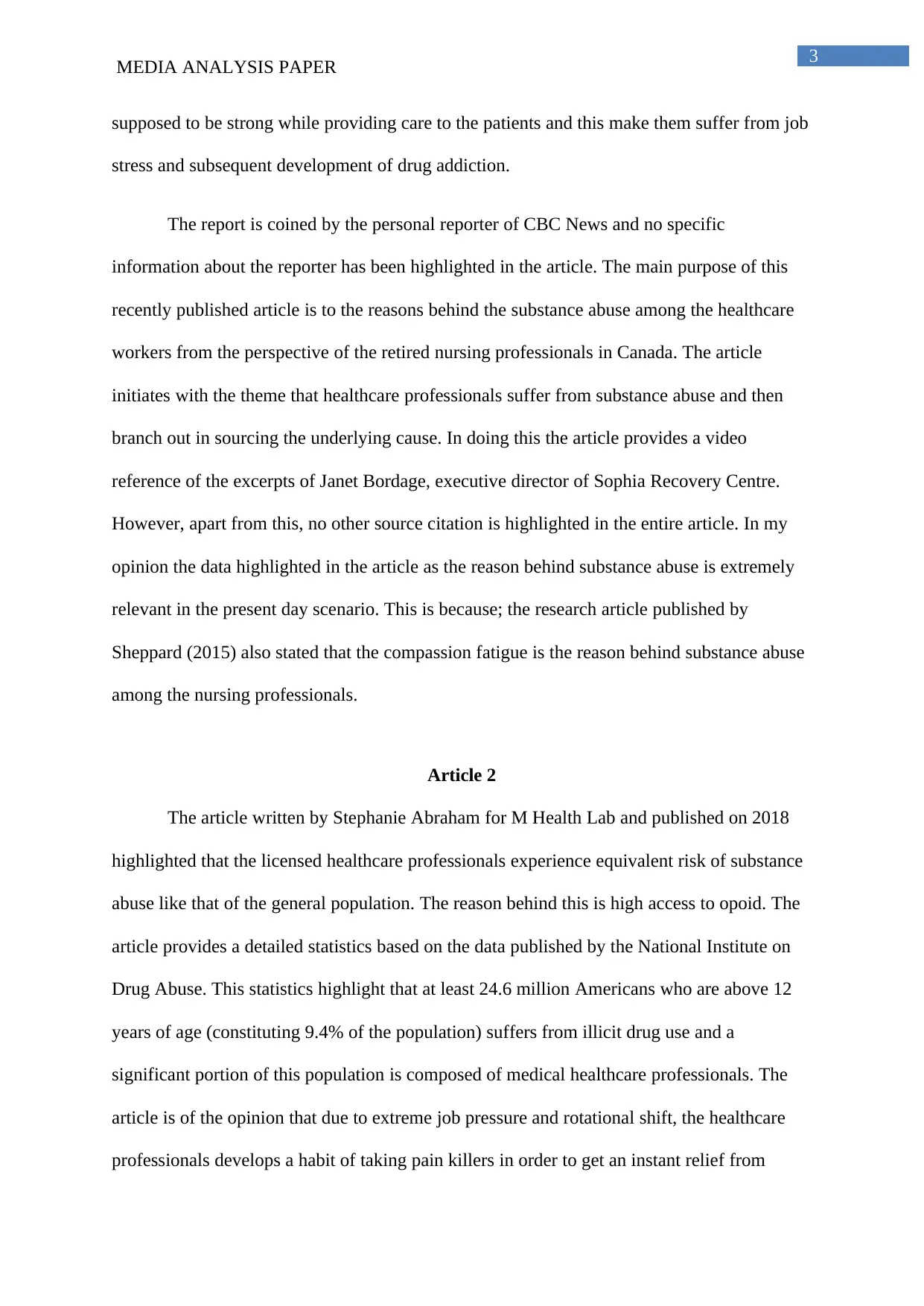
3
MEDIA ANALYSIS PAPER
supposed to be strong while providing care to the patients and this make them suffer from job
stress and subsequent development of drug addiction.
The report is coined by the personal reporter of CBC News and no specific
information about the reporter has been highlighted in the article. The main purpose of this
recently published article is to the reasons behind the substance abuse among the healthcare
workers from the perspective of the retired nursing professionals in Canada. The article
initiates with the theme that healthcare professionals suffer from substance abuse and then
branch out in sourcing the underlying cause. In doing this the article provides a video
reference of the excerpts of Janet Bordage, executive director of Sophia Recovery Centre.
However, apart from this, no other source citation is highlighted in the entire article. In my
opinion the data highlighted in the article as the reason behind substance abuse is extremely
relevant in the present day scenario. This is because; the research article published by
Sheppard (2015) also stated that the compassion fatigue is the reason behind substance abuse
among the nursing professionals.
Article 2
The article written by Stephanie Abraham for M Health Lab and published on 2018
highlighted that the licensed healthcare professionals experience equivalent risk of substance
abuse like that of the general population. The reason behind this is high access to opoid. The
article provides a detailed statistics based on the data published by the National Institute on
Drug Abuse. This statistics highlight that at least 24.6 million Americans who are above 12
years of age (constituting 9.4% of the population) suffers from illicit drug use and a
significant portion of this population is composed of medical healthcare professionals. The
article is of the opinion that due to extreme job pressure and rotational shift, the healthcare
professionals develops a habit of taking pain killers in order to get an instant relief from
MEDIA ANALYSIS PAPER
supposed to be strong while providing care to the patients and this make them suffer from job
stress and subsequent development of drug addiction.
The report is coined by the personal reporter of CBC News and no specific
information about the reporter has been highlighted in the article. The main purpose of this
recently published article is to the reasons behind the substance abuse among the healthcare
workers from the perspective of the retired nursing professionals in Canada. The article
initiates with the theme that healthcare professionals suffer from substance abuse and then
branch out in sourcing the underlying cause. In doing this the article provides a video
reference of the excerpts of Janet Bordage, executive director of Sophia Recovery Centre.
However, apart from this, no other source citation is highlighted in the entire article. In my
opinion the data highlighted in the article as the reason behind substance abuse is extremely
relevant in the present day scenario. This is because; the research article published by
Sheppard (2015) also stated that the compassion fatigue is the reason behind substance abuse
among the nursing professionals.
Article 2
The article written by Stephanie Abraham for M Health Lab and published on 2018
highlighted that the licensed healthcare professionals experience equivalent risk of substance
abuse like that of the general population. The reason behind this is high access to opoid. The
article provides a detailed statistics based on the data published by the National Institute on
Drug Abuse. This statistics highlight that at least 24.6 million Americans who are above 12
years of age (constituting 9.4% of the population) suffers from illicit drug use and a
significant portion of this population is composed of medical healthcare professionals. The
article is of the opinion that due to extreme job pressure and rotational shift, the healthcare
professionals develops a habit of taking pain killers in order to get an instant relief from
Paraphrase This Document
Need a fresh take? Get an instant paraphrase of this document with our AI Paraphraser
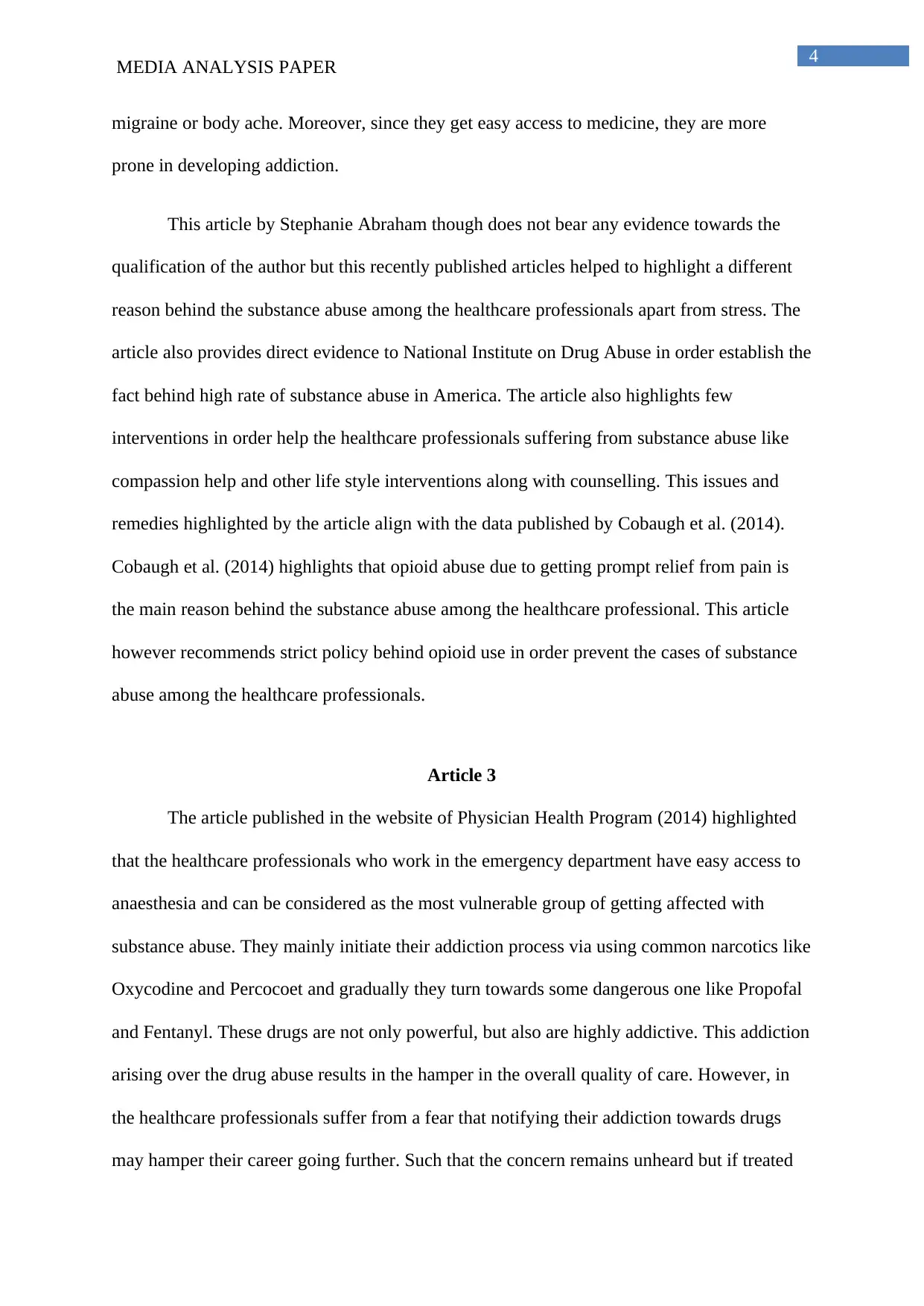
4
MEDIA ANALYSIS PAPER
migraine or body ache. Moreover, since they get easy access to medicine, they are more
prone in developing addiction.
This article by Stephanie Abraham though does not bear any evidence towards the
qualification of the author but this recently published articles helped to highlight a different
reason behind the substance abuse among the healthcare professionals apart from stress. The
article also provides direct evidence to National Institute on Drug Abuse in order establish the
fact behind high rate of substance abuse in America. The article also highlights few
interventions in order help the healthcare professionals suffering from substance abuse like
compassion help and other life style interventions along with counselling. This issues and
remedies highlighted by the article align with the data published by Cobaugh et al. (2014).
Cobaugh et al. (2014) highlights that opioid abuse due to getting prompt relief from pain is
the main reason behind the substance abuse among the healthcare professional. This article
however recommends strict policy behind opioid use in order prevent the cases of substance
abuse among the healthcare professionals.
Article 3
The article published in the website of Physician Health Program (2014) highlighted
that the healthcare professionals who work in the emergency department have easy access to
anaesthesia and can be considered as the most vulnerable group of getting affected with
substance abuse. They mainly initiate their addiction process via using common narcotics like
Oxycodine and Percocoet and gradually they turn towards some dangerous one like Propofal
and Fentanyl. These drugs are not only powerful, but also are highly addictive. This addiction
arising over the drug abuse results in the hamper in the overall quality of care. However, in
the healthcare professionals suffer from a fear that notifying their addiction towards drugs
may hamper their career going further. Such that the concern remains unheard but if treated
MEDIA ANALYSIS PAPER
migraine or body ache. Moreover, since they get easy access to medicine, they are more
prone in developing addiction.
This article by Stephanie Abraham though does not bear any evidence towards the
qualification of the author but this recently published articles helped to highlight a different
reason behind the substance abuse among the healthcare professionals apart from stress. The
article also provides direct evidence to National Institute on Drug Abuse in order establish the
fact behind high rate of substance abuse in America. The article also highlights few
interventions in order help the healthcare professionals suffering from substance abuse like
compassion help and other life style interventions along with counselling. This issues and
remedies highlighted by the article align with the data published by Cobaugh et al. (2014).
Cobaugh et al. (2014) highlights that opioid abuse due to getting prompt relief from pain is
the main reason behind the substance abuse among the healthcare professional. This article
however recommends strict policy behind opioid use in order prevent the cases of substance
abuse among the healthcare professionals.
Article 3
The article published in the website of Physician Health Program (2014) highlighted
that the healthcare professionals who work in the emergency department have easy access to
anaesthesia and can be considered as the most vulnerable group of getting affected with
substance abuse. They mainly initiate their addiction process via using common narcotics like
Oxycodine and Percocoet and gradually they turn towards some dangerous one like Propofal
and Fentanyl. These drugs are not only powerful, but also are highly addictive. This addiction
arising over the drug abuse results in the hamper in the overall quality of care. However, in
the healthcare professionals suffer from a fear that notifying their addiction towards drugs
may hamper their career going further. Such that the concern remains unheard but if treated
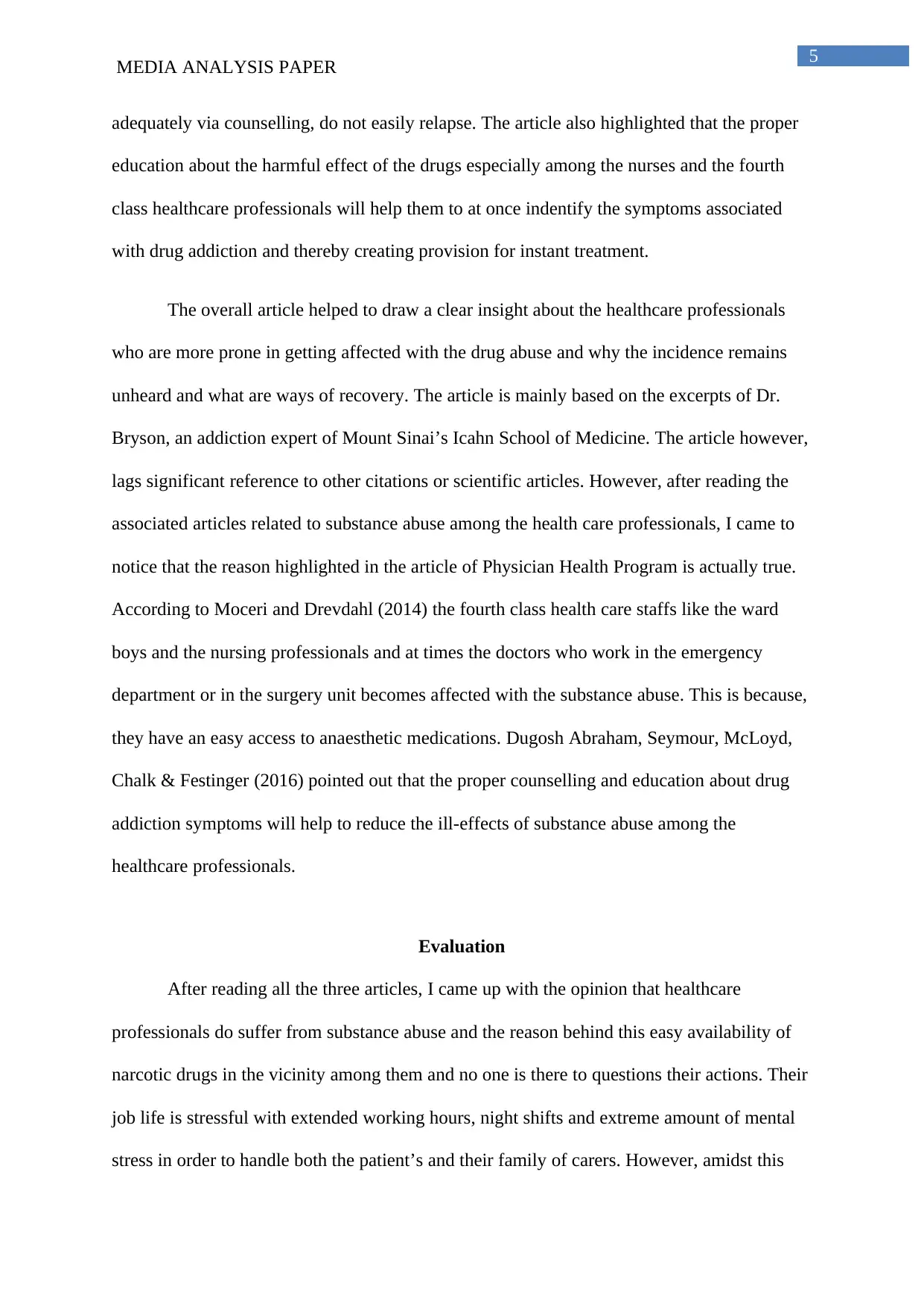
5
MEDIA ANALYSIS PAPER
adequately via counselling, do not easily relapse. The article also highlighted that the proper
education about the harmful effect of the drugs especially among the nurses and the fourth
class healthcare professionals will help them to at once indentify the symptoms associated
with drug addiction and thereby creating provision for instant treatment.
The overall article helped to draw a clear insight about the healthcare professionals
who are more prone in getting affected with the drug abuse and why the incidence remains
unheard and what are ways of recovery. The article is mainly based on the excerpts of Dr.
Bryson, an addiction expert of Mount Sinai’s Icahn School of Medicine. The article however,
lags significant reference to other citations or scientific articles. However, after reading the
associated articles related to substance abuse among the health care professionals, I came to
notice that the reason highlighted in the article of Physician Health Program is actually true.
According to Moceri and Drevdahl (2014) the fourth class health care staffs like the ward
boys and the nursing professionals and at times the doctors who work in the emergency
department or in the surgery unit becomes affected with the substance abuse. This is because,
they have an easy access to anaesthetic medications. Dugosh Abraham, Seymour, McLoyd,
Chalk & Festinger (2016) pointed out that the proper counselling and education about drug
addiction symptoms will help to reduce the ill-effects of substance abuse among the
healthcare professionals.
Evaluation
After reading all the three articles, I came up with the opinion that healthcare
professionals do suffer from substance abuse and the reason behind this easy availability of
narcotic drugs in the vicinity among them and no one is there to questions their actions. Their
job life is stressful with extended working hours, night shifts and extreme amount of mental
stress in order to handle both the patient’s and their family of carers. However, amidst this
MEDIA ANALYSIS PAPER
adequately via counselling, do not easily relapse. The article also highlighted that the proper
education about the harmful effect of the drugs especially among the nurses and the fourth
class healthcare professionals will help them to at once indentify the symptoms associated
with drug addiction and thereby creating provision for instant treatment.
The overall article helped to draw a clear insight about the healthcare professionals
who are more prone in getting affected with the drug abuse and why the incidence remains
unheard and what are ways of recovery. The article is mainly based on the excerpts of Dr.
Bryson, an addiction expert of Mount Sinai’s Icahn School of Medicine. The article however,
lags significant reference to other citations or scientific articles. However, after reading the
associated articles related to substance abuse among the health care professionals, I came to
notice that the reason highlighted in the article of Physician Health Program is actually true.
According to Moceri and Drevdahl (2014) the fourth class health care staffs like the ward
boys and the nursing professionals and at times the doctors who work in the emergency
department or in the surgery unit becomes affected with the substance abuse. This is because,
they have an easy access to anaesthetic medications. Dugosh Abraham, Seymour, McLoyd,
Chalk & Festinger (2016) pointed out that the proper counselling and education about drug
addiction symptoms will help to reduce the ill-effects of substance abuse among the
healthcare professionals.
Evaluation
After reading all the three articles, I came up with the opinion that healthcare
professionals do suffer from substance abuse and the reason behind this easy availability of
narcotic drugs in the vicinity among them and no one is there to questions their actions. Their
job life is stressful with extended working hours, night shifts and extreme amount of mental
stress in order to handle both the patient’s and their family of carers. However, amidst this
⊘ This is a preview!⊘
Do you want full access?
Subscribe today to unlock all pages.

Trusted by 1+ million students worldwide
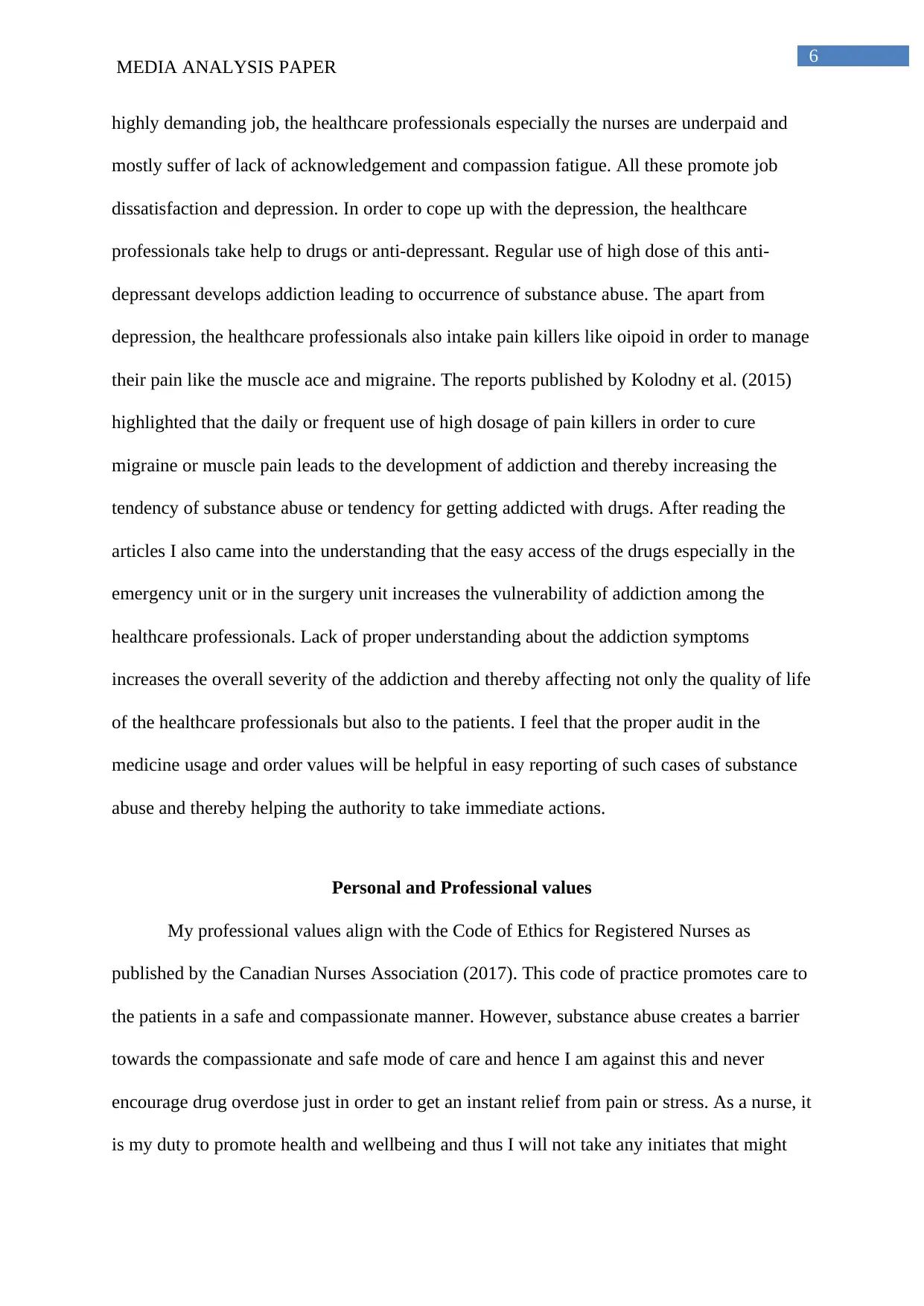
6
MEDIA ANALYSIS PAPER
highly demanding job, the healthcare professionals especially the nurses are underpaid and
mostly suffer of lack of acknowledgement and compassion fatigue. All these promote job
dissatisfaction and depression. In order to cope up with the depression, the healthcare
professionals take help to drugs or anti-depressant. Regular use of high dose of this anti-
depressant develops addiction leading to occurrence of substance abuse. The apart from
depression, the healthcare professionals also intake pain killers like oipoid in order to manage
their pain like the muscle ace and migraine. The reports published by Kolodny et al. (2015)
highlighted that the daily or frequent use of high dosage of pain killers in order to cure
migraine or muscle pain leads to the development of addiction and thereby increasing the
tendency of substance abuse or tendency for getting addicted with drugs. After reading the
articles I also came into the understanding that the easy access of the drugs especially in the
emergency unit or in the surgery unit increases the vulnerability of addiction among the
healthcare professionals. Lack of proper understanding about the addiction symptoms
increases the overall severity of the addiction and thereby affecting not only the quality of life
of the healthcare professionals but also to the patients. I feel that the proper audit in the
medicine usage and order values will be helpful in easy reporting of such cases of substance
abuse and thereby helping the authority to take immediate actions.
Personal and Professional values
My professional values align with the Code of Ethics for Registered Nurses as
published by the Canadian Nurses Association (2017). This code of practice promotes care to
the patients in a safe and compassionate manner. However, substance abuse creates a barrier
towards the compassionate and safe mode of care and hence I am against this and never
encourage drug overdose just in order to get an instant relief from pain or stress. As a nurse, it
is my duty to promote health and wellbeing and thus I will not take any initiates that might
MEDIA ANALYSIS PAPER
highly demanding job, the healthcare professionals especially the nurses are underpaid and
mostly suffer of lack of acknowledgement and compassion fatigue. All these promote job
dissatisfaction and depression. In order to cope up with the depression, the healthcare
professionals take help to drugs or anti-depressant. Regular use of high dose of this anti-
depressant develops addiction leading to occurrence of substance abuse. The apart from
depression, the healthcare professionals also intake pain killers like oipoid in order to manage
their pain like the muscle ace and migraine. The reports published by Kolodny et al. (2015)
highlighted that the daily or frequent use of high dosage of pain killers in order to cure
migraine or muscle pain leads to the development of addiction and thereby increasing the
tendency of substance abuse or tendency for getting addicted with drugs. After reading the
articles I also came into the understanding that the easy access of the drugs especially in the
emergency unit or in the surgery unit increases the vulnerability of addiction among the
healthcare professionals. Lack of proper understanding about the addiction symptoms
increases the overall severity of the addiction and thereby affecting not only the quality of life
of the healthcare professionals but also to the patients. I feel that the proper audit in the
medicine usage and order values will be helpful in easy reporting of such cases of substance
abuse and thereby helping the authority to take immediate actions.
Personal and Professional values
My professional values align with the Code of Ethics for Registered Nurses as
published by the Canadian Nurses Association (2017). This code of practice promotes care to
the patients in a safe and compassionate manner. However, substance abuse creates a barrier
towards the compassionate and safe mode of care and hence I am against this and never
encourage drug overdose just in order to get an instant relief from pain or stress. As a nurse, it
is my duty to promote health and wellbeing and thus I will not take any initiates that might
Paraphrase This Document
Need a fresh take? Get an instant paraphrase of this document with our AI Paraphraser
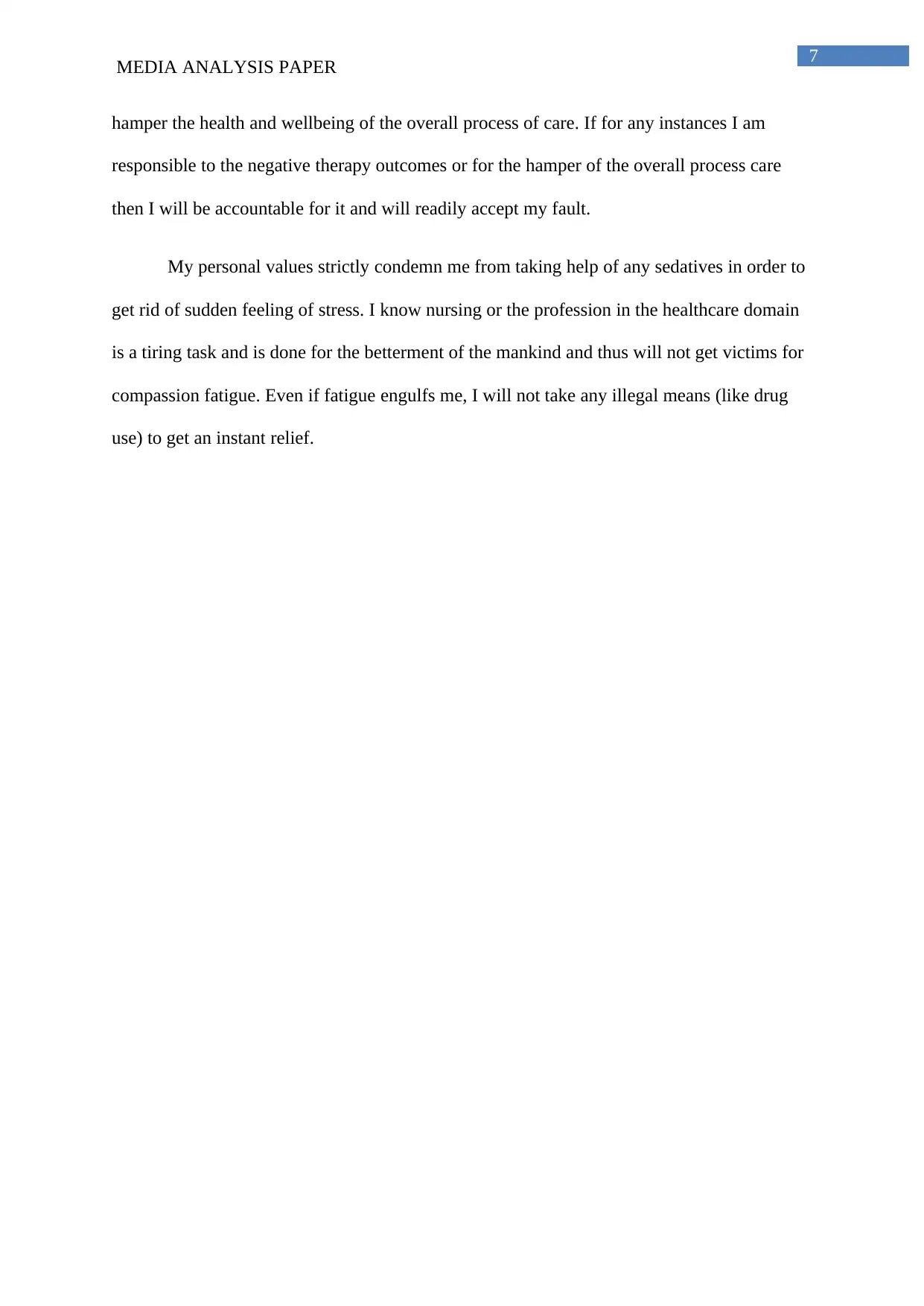
7
MEDIA ANALYSIS PAPER
hamper the health and wellbeing of the overall process of care. If for any instances I am
responsible to the negative therapy outcomes or for the hamper of the overall process care
then I will be accountable for it and will readily accept my fault.
My personal values strictly condemn me from taking help of any sedatives in order to
get rid of sudden feeling of stress. I know nursing or the profession in the healthcare domain
is a tiring task and is done for the betterment of the mankind and thus will not get victims for
compassion fatigue. Even if fatigue engulfs me, I will not take any illegal means (like drug
use) to get an instant relief.
MEDIA ANALYSIS PAPER
hamper the health and wellbeing of the overall process of care. If for any instances I am
responsible to the negative therapy outcomes or for the hamper of the overall process care
then I will be accountable for it and will readily accept my fault.
My personal values strictly condemn me from taking help of any sedatives in order to
get rid of sudden feeling of stress. I know nursing or the profession in the healthcare domain
is a tiring task and is done for the betterment of the mankind and thus will not get victims for
compassion fatigue. Even if fatigue engulfs me, I will not take any illegal means (like drug
use) to get an instant relief.
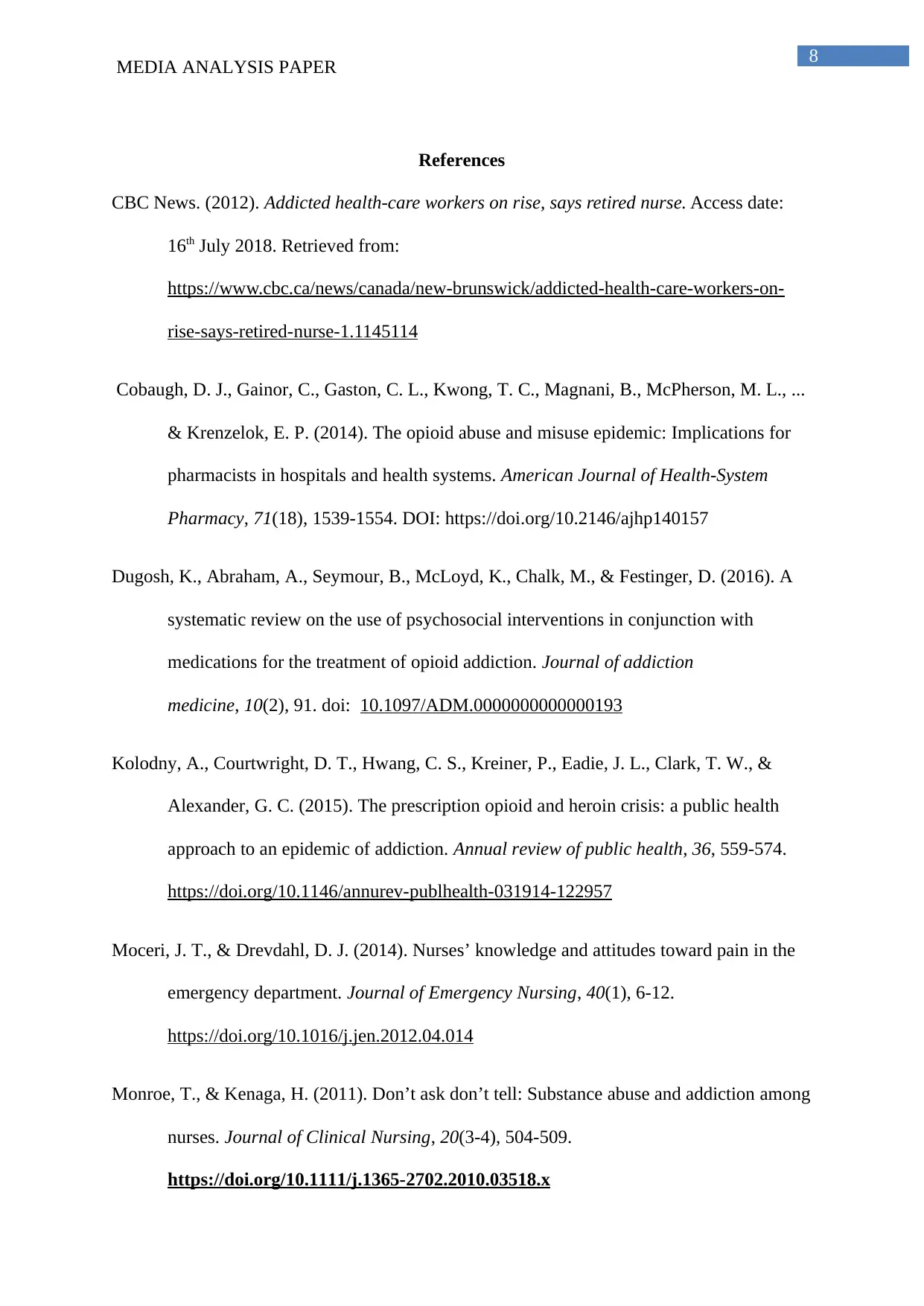
8
MEDIA ANALYSIS PAPER
References
CBC News. (2012). Addicted health-care workers on rise, says retired nurse. Access date:
16th July 2018. Retrieved from:
https://www.cbc.ca/news/canada/new-brunswick/addicted-health-care-workers-on-
rise-says-retired-nurse-1.1145114
Cobaugh, D. J., Gainor, C., Gaston, C. L., Kwong, T. C., Magnani, B., McPherson, M. L., ...
& Krenzelok, E. P. (2014). The opioid abuse and misuse epidemic: Implications for
pharmacists in hospitals and health systems. American Journal of Health-System
Pharmacy, 71(18), 1539-1554. DOI: https://doi.org/10.2146/ajhp140157
Dugosh, K., Abraham, A., Seymour, B., McLoyd, K., Chalk, M., & Festinger, D. (2016). A
systematic review on the use of psychosocial interventions in conjunction with
medications for the treatment of opioid addiction. Journal of addiction
medicine, 10(2), 91. doi: 10.1097/ADM.0000000000000193
Kolodny, A., Courtwright, D. T., Hwang, C. S., Kreiner, P., Eadie, J. L., Clark, T. W., &
Alexander, G. C. (2015). The prescription opioid and heroin crisis: a public health
approach to an epidemic of addiction. Annual review of public health, 36, 559-574.
https://doi.org/10.1146/annurev-publhealth-031914-122957
Moceri, J. T., & Drevdahl, D. J. (2014). Nurses’ knowledge and attitudes toward pain in the
emergency department. Journal of Emergency Nursing, 40(1), 6-12.
https://doi.org/10.1016/j.jen.2012.04.014
Monroe, T., & Kenaga, H. (2011). Don’t ask don’t tell: Substance abuse and addiction among
nurses. Journal of Clinical Nursing, 20(3‐4), 504-509.
https://doi.org/10.1111/j.1365-2702.2010.03518.x
MEDIA ANALYSIS PAPER
References
CBC News. (2012). Addicted health-care workers on rise, says retired nurse. Access date:
16th July 2018. Retrieved from:
https://www.cbc.ca/news/canada/new-brunswick/addicted-health-care-workers-on-
rise-says-retired-nurse-1.1145114
Cobaugh, D. J., Gainor, C., Gaston, C. L., Kwong, T. C., Magnani, B., McPherson, M. L., ...
& Krenzelok, E. P. (2014). The opioid abuse and misuse epidemic: Implications for
pharmacists in hospitals and health systems. American Journal of Health-System
Pharmacy, 71(18), 1539-1554. DOI: https://doi.org/10.2146/ajhp140157
Dugosh, K., Abraham, A., Seymour, B., McLoyd, K., Chalk, M., & Festinger, D. (2016). A
systematic review on the use of psychosocial interventions in conjunction with
medications for the treatment of opioid addiction. Journal of addiction
medicine, 10(2), 91. doi: 10.1097/ADM.0000000000000193
Kolodny, A., Courtwright, D. T., Hwang, C. S., Kreiner, P., Eadie, J. L., Clark, T. W., &
Alexander, G. C. (2015). The prescription opioid and heroin crisis: a public health
approach to an epidemic of addiction. Annual review of public health, 36, 559-574.
https://doi.org/10.1146/annurev-publhealth-031914-122957
Moceri, J. T., & Drevdahl, D. J. (2014). Nurses’ knowledge and attitudes toward pain in the
emergency department. Journal of Emergency Nursing, 40(1), 6-12.
https://doi.org/10.1016/j.jen.2012.04.014
Monroe, T., & Kenaga, H. (2011). Don’t ask don’t tell: Substance abuse and addiction among
nurses. Journal of Clinical Nursing, 20(3‐4), 504-509.
https://doi.org/10.1111/j.1365-2702.2010.03518.x
⊘ This is a preview!⊘
Do you want full access?
Subscribe today to unlock all pages.

Trusted by 1+ million students worldwide
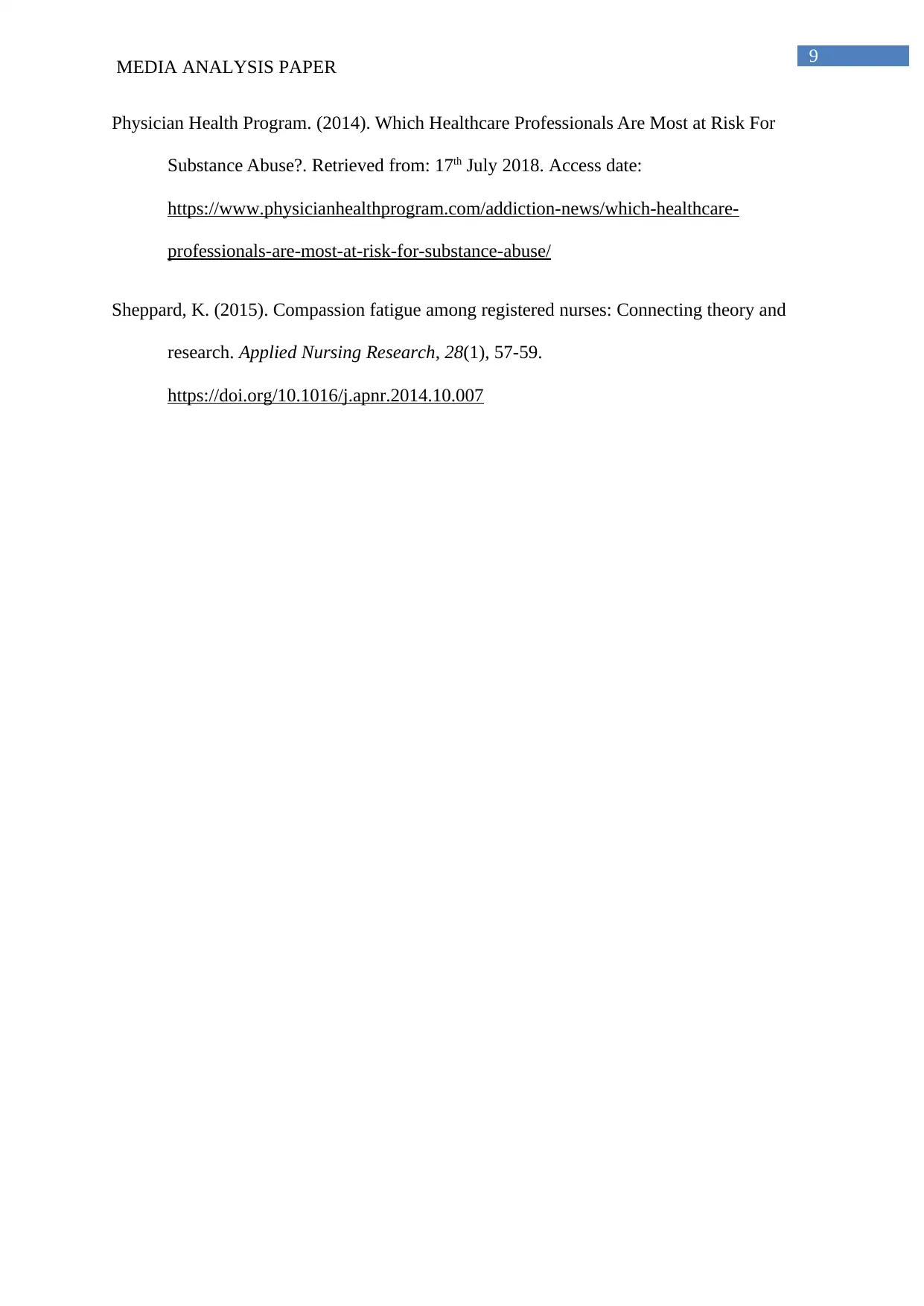
9
MEDIA ANALYSIS PAPER
Physician Health Program. (2014). Which Healthcare Professionals Are Most at Risk For
Substance Abuse?. Retrieved from: 17th July 2018. Access date:
https://www.physicianhealthprogram.com/addiction-news/which-healthcare-
professionals-are-most-at-risk-for-substance-abuse/
Sheppard, K. (2015). Compassion fatigue among registered nurses: Connecting theory and
research. Applied Nursing Research, 28(1), 57-59.
https://doi.org/10.1016/j.apnr.2014.10.007
MEDIA ANALYSIS PAPER
Physician Health Program. (2014). Which Healthcare Professionals Are Most at Risk For
Substance Abuse?. Retrieved from: 17th July 2018. Access date:
https://www.physicianhealthprogram.com/addiction-news/which-healthcare-
professionals-are-most-at-risk-for-substance-abuse/
Sheppard, K. (2015). Compassion fatigue among registered nurses: Connecting theory and
research. Applied Nursing Research, 28(1), 57-59.
https://doi.org/10.1016/j.apnr.2014.10.007
1 out of 10
Related Documents
Your All-in-One AI-Powered Toolkit for Academic Success.
+13062052269
info@desklib.com
Available 24*7 on WhatsApp / Email
![[object Object]](/_next/static/media/star-bottom.7253800d.svg)
Unlock your academic potential
Copyright © 2020–2025 A2Z Services. All Rights Reserved. Developed and managed by ZUCOL.





